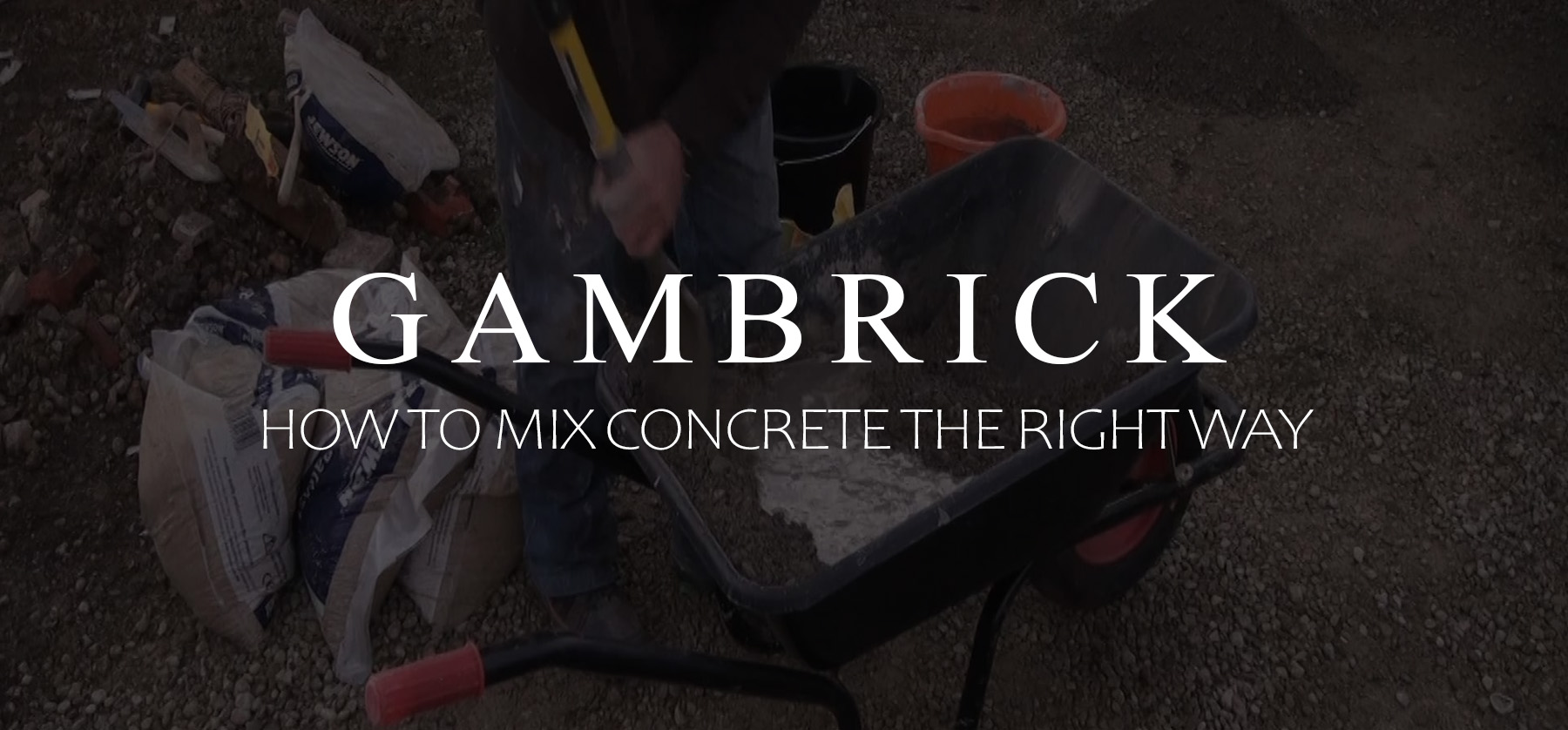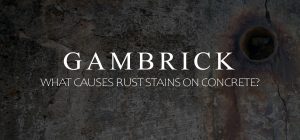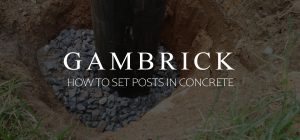
How To Mix Concrete The Right Way
Mixing concrete is easy to do and only requires a few basic tools. Whether your using premixed bags like Quikrete or making your own, the mixing process is the same. All you need is somewhere to mix it, like a tray or wheelbarrow, a tool to mix it with, like a shovel, hoe or trowel, and fresh water. In general, 3 quarts of water are needed to mix an 80 lb. bag on concrete. Add the water in slowly to avoid over watering. Properly mixed concrete should look like thick oatmeal. It shouldn’t be powdery or watery.
Concrete can also be mixed by machine. You can rent a concrete mixer by the day for around $50 at Home Depot. Pour your dry concrete mix into the mixing drum and add water. It’s just that simple.
Mixing concrete is a very simple process, but mixing it to the right consistency is a little more challenging. When finished, you should be able to pick up the concrete with your hand and form it like a snowball.
Concrete is made by mixing sand, cement, and stone together with water. I’ve been making concrete on my jobsites for over 25 years and can tell you firsthand that water and the mix ratio the most important parts of making strong concrete. Over watering, under watering, or using the wrong mix can make concrete weaker, brittle and prone to cracks.
If your concrete doesn’t form like a snowball, adjust your water level as needed.
Don’t forget your additives. They give your concrete additional attributes like flexibility, more strength, fast setting, crack resistance or color. Some are added when dry and others when wet.
Tools Required To Mix Concrete
Mixing concrete by hand is very easy to do and only requires a few basic tools.
- Bucket. For measuring and carrying your water. I use the 5 gallon buckets from Home Depot or Lowes.
- Mixing Tray. Get one big enough to handle a few bags at a time. Make sure it’s made out of metal or strong plastic.
- Shovel, Hoe or Trowel. To mix the concrete with. I prefer a hoe but any of these tools will do. A spade head shovel works better than a flat head because it digs into the concrete easier.
- Wheelbarrow. I prefer mixing in a wheelbarrow instead of a tray. Especially if the concrete needs to be moved around. A wheelbarrow also makes dumping concrete into a hole or footing much easier.
- Safety Equipment. Mixing concrete isn’t dangerous work but safety gear is always a good idea. I doubt breathing in concrete dust is good for you so I like to wear a mask. And I don’t want unmixed or mixed concrete in my eyes so I always wear goggles. Concrete can really dry out and crack your skin so consider wearing gloves that are water proof. And lift carefully.
- Concrete Mixer. If you don’t want to mix the concrete by hand then rent or buy a drum mixer. They’re very easy to use and make mixing concrete super easy. You still need a wheelbarrow to move the concrete around though.
- Knife. I always carry a utility knife with me in case I have to cut open Quikrete or ingredient bags like Portland Cement.
Safety First
Safety is very important no matter what type of construction work you’re doing. And even though mixing concrete is a relatively safe job, there are still some precautions you can take.
- Make sure to wear safety glasses and rubber gloves to protect your eyes and hands from the concrete. Concrete definitely isn’t good to get in your eyes and can really dry out and crack your skin.
- Where a mask so you don’t breathe in all that concrete dust. If you’ve never poured out a bag of premixed concrete you may be surprised at how much dust it creates.
- Be careful when lifting the bags and handling concrete. 80lb bags are pretty heavy, even if your in shape and used to dealing with concrete you should still lift carefully. Even the lighter 60 lb bags are more than enough to injure your back if you don’t lift carefully.
Step By Step Mixing Instructions
When working with cement based products like Concrete, always wear eye protection and waterproof gloves. I also recommend wearing a mask when you pour dry concrete into the tray, wheelbarrow or mixer because a lot of dust will kick up. And make sure to lift carefully, concrete is heavy.
1. Pour Concrete Into Your Wheelbarrow, Tub or Mixer
Empty the dry concrete mix into your mortar tub, mixer or wheelbarrow.
If your using a tub, make sure it provides enough depth and space to hold the concrete mix. I like to get one big enough for at least 2-3 80 lb. bags. The best way I’ve found to pour concrete is to cut a line vertically through the middle of the bag with my utility knife. The top and bottom of the bag are folded over with flaps so many times that it’s hard to cut through. But the middle of the bag is easy because it’s just a single layer thick. Also, by cutting the middle you can use the edges as handles to hold the bag with. It makes pouring out the concrete a bit easier and less awkward.
If your using a wheelbarrow the advise is pretty much the same. Buy one that’s big enough to mix at least 2-3 bags at once. And also make sure its strong enough to carry the load. Mixed concrete can be pretty heavy. I like to buy a wheelbarrow that’s rated to carry at least 250 lbs. +
Pro Tip: Make sure you place the mixing tub or wheelbarrow near the project. Concrete gets even heavier once you add water so it’s best to mix right where you need it. Otherwise you’ll be dragging that heavy tub or wheelbarrow around the job site which risks a spill and injury. I’ve seen plenty of dumped wheelbarrows and injured backs in my career.
2. Form A Depression
Form a depression or hole in the middle of the mix to pour your water into.
This part isn’t required when using a machine concrete mixer because it does all the work for you. Once the Quikrete bag is poured into the tub or wheelbarrow, use your hand or a tool to make an indent in the mix. An indent makes pouring in your water and mixing the concrete a little easier.
3. Measure The Water
Carefully measure out the amount of water you need. This isn’t something you should rush. Other than the concrete itself, the most important part to creating strong concrete is water. You need just enough water to get a good, thorough mix but not too much. Both too much and too little water will weaken the concrete. In most cases 3 quarts of water are required for 80 lbs. of Concrete.
Any fresh water is typically fine to mix with concrete. It doesn’t matter if it’s from the tap, a hose or a well. Just don’t use salt water. Salt will weaken your concrete.
The correct ratio of water to Quikrete mix is 3 quarts of water for each 80 pound bag.
Pro Tip: Measure out your water the first time and then pour it into a 5 gallon bucket. Make a mark that will act as your fill line. This is a fast and easy way to always get the water right. For each 80 lb. bag of concrete you mix, simply fill your bucket to the fill line and pour it into your dry mix.
4. Pour Water Into The Dry Concrete & Mix It
Pour water into the depression you made earlier. Only pour about 2/3 of the water into the dry concrete mix. Mix the water and dry concrete together until your water is completely soaked up.
Once the 2/3rds water and concrete is fully mixed, slowly pour the remaining water in as needed.
Work the mix with a tool, gradually adding water, until the mix reaches a uniform consistency. Properly mixed concrete will look like thick oatmeal and hold its shape. You should be able to form concrete in your hand like a snow ball. If the concrete is like soup then add more dry mix to balance it out. If the concrete is too dry with unmixed concrete, add some water.
Do Not use more water than is required. Excess water weakens concrete. It makes concrete brittle and prone to cracking. Many people are tempted to do it because wet concrete is easier to work with, but dry concrete is much stronger. The more water that’s added to the mix the weaker it becomes. Adding one extra quart of water to an 80 lb bag can reduce it’s strength by up to 40%. Just make sure not to add too little.
Mixing The Concrete
To mix concrete and water together by hand, most people use a hoe, shovel or trowel. This ensures the concrete is mixed thoroughly which produces the best outcome. If you don’t mix the concrete well enough, sections can remain dry and powdery.
Don’t forget the edges and sides of the tray or wheel barrow. If you do, the concrete in the middle of the tray will get too much water and become weakened. Make sure to mix all the concrete equally and evenly.
Don’t add more water to the dry edges and sides if it builds up. This will make the mixture too watery. Use only the recommended 3 quarts of water for a single 80 lb. bag of concrete.
If you don’t have a tool to mix with you can actually use just about anything. Even your hands will do. Tools make the job a lot easier but they’re not essential. As long as the concrete is mixed thoroughly with the right amount of water it doesn’t matter what you mixed it with.
Technique doesn’t really matter here either. I prefer to use a hoe to mix my concrete because the motion is easier for me. But some masons prefer a shovel and others a trowel. Try different tools out and see what works best for you.
If your using a shovel I recommend a spade tip. That’s the one with the pointed tip. It makes digging into the concrete easier as you mix it. A flat head shovel can be hard to jab into the concrete. Especially if your mix has large aggregate.
The Correct Consistency
The more water you add to dry concrete, the weaker it becomes. Too much water can create weak, brittle concrete which leads to cracks and structural problems.
The consistency that your going for is thick oatmeal. It’s moist and workable but still semi solid and can hold form. Once you think the mixture is mixed properly, pick some up and form it into a ball. If the concrete can hold its shape, then it’s ready to be used.
If the concrete feels too dry and lacks the consistency needed or you see unmixed dry spots, slowly add more water as needed. Don’t add too much too fast because at this point a little bit of water goes a long way.
Concrete contains cement which becomes a paste when wet. This paste is what makes concrete easy to form and smooth. Too much water and the paste becomes liquid and can’t hold form, too little and the concrete is overly dry and stiff.
If the mixture feels too wet and won’t hold its shape, slowly add a little more concrete powder. Mix in a little at a time until the concrete hardens up to the consistency you want.
Cleanup
Once the work is done don’t forget to clean off all your tools. Also pay attention to the area around where you mixed. Concrete tends to splash while you mix it and it’s easy to get some on some siding, a fence or other surroundings.
Concrete will dry up and stain whatever it sticks too. Even if you get it later, it can still leave a stain. Sometimes concrete hardens and can damage equipment when you try to clean it off. Make sure to clean concrete right away.
When you do it quickly, concrete can be cleaned off with a simple garden hose. Just wash it off until all that’s left is sand and stone. The cement will wash away with the water.
If the concrete dries then you need to break it off whatever it’s stuck too. This isn’t hard to do but can damage whatever it’s stuck on so be careful. It can also leave a stain behind, especially if it’s stuck to vinyl like a fence or siding.
Summary: How To Mix Quikrete Concrete
How to mix concrete by hand is easy to do and only requires a few basic tools. Whether your using premixed bags like Quikrete or making your own, the mixing process is the same. All you need is somewhere to mix it, like a tray or wheelbarrow, a tool to mix it with, like a shovel, hoe or trowel, and fresh water. In general, 3 quarts of water are needed to mix an 80 lb. bag on concrete. Add the water in slowly to avoid over watering. Properly mixed concrete should look like thick oatmeal. Make sure to mix the concrete evenly and thoroughly so that there are no dry spots.
Concrete can also be mixed by machine. You can rent a concrete mixer by the day for around $50 at Home Depot. Pour your dry concrete mix into the mixing drum and add water. It’s just that simple.
Mixing concrete is a very simple process, but mixing it to the right consistency is a little more challenging. When finished, you should be able to pick up the concrete with your hand and form it like a snowball. Water is the most important part of mixing concrete correctly. Over watering makes concrete weaker, brittle and prone to cracks. Too little water leaves dry unmixed spots which are also brittle and weak. If your concrete doesn’t pass the form test then adjust your water level as needed.
And don’t forget your additives. They give your concrete additional attributes like flexibility, more strength, fast setting, crack resistance or color. Some are added when dry and others when wet. Check the label on whatever your adding.
If you have any questions or comments e-mail us any time. We’d love to hear from you.

John Mazzuca | About | More Posts |
Custom Home Builder
John Mazzuca is a custom home designer and builder at Gambrick with over 25 years experience in the construction industry. John has designed, built and/or remodeled hundreds of homes, small buildings, and commercial projects. He writes about business, real estate, home building, and household electronics. His work has been featured in Fox Business, Better Homes & Garden, House Beautiful, and more.




















